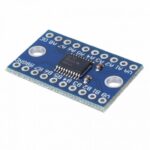The ESP32 is a low-power Wi-Fi and Bluetooth SoC (System on Chip) that comes in different development board variants. Here are some of the general features and specifications of an ESP32 board:
1.Port: USB Type-C Port.
2.Microcontroller: ESP32 chip with a dual-core 32-bit processor, operating at up to 240 MHz.
3.Connectivity: Built-in Wi-Fi and Bluetooth connectivity, with support for BLE (Bluetooth Low Energy) and classic Bluetooth protocols.
5.GPIO: Multiple GPIO (General Purpose Input Output) pins for external devices, sensors, and other peripherals. ESP32 boards typically have 20-36 GPIO pins.
6.Analog Inputs: Multiple channels of 12-bit ADC (Analog-to-Digital Converter) for analog inputs.
7.Power: Can be powered via USB or an external power source.
8.Debugging: Supports serial communication for debugging and programming, as well as JTAG (Joint Test Action Group) debugging.
9.Flash memory: Built-in flash memory for storing code and data. ESP32 boards typically have 4MB-16MB of flash memory.
10.Operating voltage: Supports 3.3V and 5V operating voltage.
11.Development environment: Can be programmed using the Arduino IDE, MicroPython, Lua, or the ESP-IDF (Espressif IoT Development Framework), which includes support for FreeRTOS and other libraries.
Additional features: Some ESP32 boards may also include additional features such as a microSD card slot, a TFT display connector, a camera connector, and more.
Overall, the ESP32 is a versatile and powerful platform for developing IoT applications. Its built-in Wi-Fi and Bluetooth connectivity, along with its multiple GPIO and ADC pins, make it ideal for connecting to sensors and other external devices. Its compatibility with multiple programming languages and development environments also makes it accessible to a wide range of developers.






















